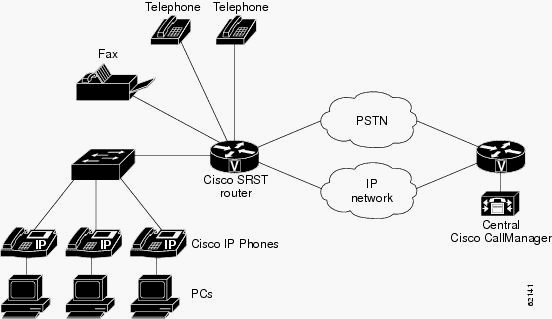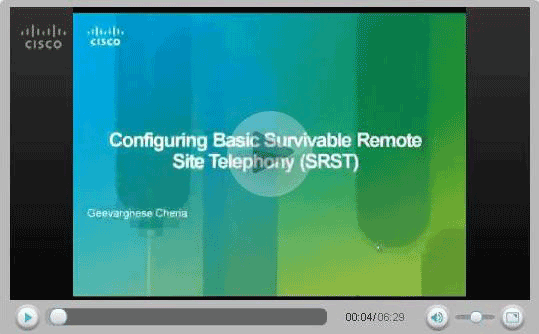Configuring SRS Telephony and MGCP Fallback
Available Languages
Contents
Introduction
If you have both Survival Remote Site Telephony (SRST) version 2.0 or later and Media Gateway Control Protocol (MGCP) fallback configured on the gateway, use this document in order to solve either of these MGCP failover problems:
-
A telephone on a Foreign Exchange Station (FXS) port does not get a dial tone, or you cannot make incoming calls through a Foreign Exchange Office (FXO) port or through the ISDN link.
-
You cannot make incoming calls with direct inward dial (DID) to an MGCP gateway, configured for MGCP fallback, in a failover situation.
Prerequisites
Requirements
There are no specific requirements for this document.
Components Used
The information in this document is based on this software version:
-
Cisco IOS® Software Release 12.2(11)T and later
Conventions
Refer to Cisco Technical Tips Conventions for more information on document conventions.
No Dial Tone on an FXS Port, or Cannot Make Incoming Calls through FXO Ports or ISDN Links
This problem is explained in detail in this section.
You are presented with a telephone on an FXS port that does not get a dial tone, or you cannot make incoming calls through an FXO port or ISDN link. In such situations, this is configured under the relevant plain old telephone service (POTS) dial peer:
dial-peer voice X pots
application mgcpapp
Note: For Cisco IOS Software Release 12.3(7)T or later, the application mgcpapp command must not be applied to the POTS dial peer that supports PRI Backhaul.
In this situation, an error message similar to this appears on the console of the Cisco IOS gateway:
*Mar 1 20:41:58.571: %CALL_CONTROL-6-APP_NOT_FOUND: Application mgcp in dial-peer 10 not found. Handing callid 13 to the alternate app.
Note: For Cisco IOS Software Release 12.4(8c) or later, when the application mgcpapp command is applied:
In this situation, a Warning message similar to this appears on the console of the Cisco IOS gateway:
Warning: This command has been deprecated and will be automatically
converted to the following:
service mgcp
For Cisco IOS Software Release 12.3(7)T or later, the application mgcpapp command should not be applied to the POTS dial peer.
Solutions
Figure 1: Branch Office Cisco IP Phones Connected to a Remote Central Cisco CallManager 
If the Cisco CallManager becomes inaccessible, phones can use a Cisco voice router for call processing. Phones go into SRST mode when either of these occurs:
-
The WAN link to the Cisco CallManager at the central site goes down.
-
The connection to the Cisco CallManager is lost.
SRST allows phones in branch offices to continue to function until the WAN link comes up or until the phones can register with a Cisco CallManager again.
Use one of the solutions described in this section to resolve this problem.
Solution 1
For the router to fallback to the default application, configure this command in global configuration mode:
For Cisco IOS Software Release 12.3(13)T or earlier:
R(config)#call application alternate default
For Cisco IOS Software Release 12.3(14)T or later:
R(config)#application R(config-app)#global R(config-app-global)#service alternate Default
If the MGCP application is not available, the default application takes over.
Solution 2
You must create a different POTS dial-peer (default application H323) to use in the fallback mode.
No Incoming Calls with DID to an MGCP Gateway in Failover
This problem is explained in detail in this section.
You cannot make incoming calls, with DID, to an MGCP gateway configured for MGCP failover in a failover situation—even though there is a connection, the phone does not ring. This is an example of the debug isdn q931 command used on the Cisco IOS gateway, when you verify this problem:
| Problem Verification Example |
|---|
*Mar 1 20:53:33.511: ISDN Se1/0:15 Q931: RX <- SETUP pd = 8 callref = 0x000A
Bearer Capability i = 0x8090A3
Standard = CCITT
Transer Capability = Speech
Transfer Mode = Circuit
Transfer Rate = 64 kbit/s
Channel ID i = 0xA98381
Exclusive, Channel 1
Calling Party Number i = 0x00, 0xA2, '5000'
Plan:Unknown, Type:Unknown
Called Party Number i = 0xC1, '5002'
Plan:ISDN, Type:Subscriber(local)
*Mar 1 20:53:33.543: ISDN Se1/0:15 Q931: TX -> CALL_PROC pd = 8 callref = 0x800A
Channel ID i = 0xA98381
Exclusive, Channel 1
*Mar 1 20:53:33.543: ISDN Se1/0:15 Q931: TX -> CONNECT pd = 8 callref = 0x800A
*Mar 1 20:53:33.595: ISDN Se1/0:15 Q931: RX <- CONNECT_ACK pd = 8 callref = 0x000A
*Mar 1 20:53:40.045: ISDN Se1/0:15 Q931: RX <- DISCONNECT pd = 8 callref = 0x000A
Cause i = 0x8090 - Normal call clearing
*Mar 1 20:53:40.057: ISDN Se1/0:15 Q931: TX -> RELEASE pd = 8 callref = 0x800A
*Mar 1 20:53:40.073: ISDN Se1/0:15 Q931: RX <- RELEASE_COMP pd = 8 callref = 0x000A |
Solution
The solution to this problem is explained in detail in this section.
You must verify that you have made these configurations on the relevant POTS dial peer:
dial-peer voice X pots
application mgcpapp
incoming called-number .
direct-inward-dial
port 1/0:15
Note: For Cisco IOS Software Release 12.3(7)T or later, the application mgcpapp command must not be applied to the POTS dial peer that supports PRI Backhaul.
This is an example of a proper configuration:
| Configuration Example |
|---|
isdn switch-type primary-net5 ! ! ccm-manager fallback-mgcp ccm-manager mgcp ccm-manager config mta receive maximum-recipients 0 ! controller E1 1/0 . pri-group timeslots 1-12,16 service mgcp ! controller E1 1/1 ! ! ! interface Ethernet0/0 ip address 10.48.80.9 255.255.255.0 duplex auto speed auto ! interface Serial1/0:15 no ip address no logging event link-status isdn switch-type primary-net5 isdn incoming-voice voice isdn bind-l3 ccm-manager no cdp enable ! ! ! call rsvp-sync ! call application alternate DEFAULT !--- For Cisco IOS® Software Release 12.3(14)T or later, this command was replaced by the service command in global application configuration mode. application global service alternate Default Refer to Solution 1 for the command syntax. ! voice-port 1/0:15 ! mgcp mgcp dtmf-relay voip codec all mode cisco mgcp package-capability rtp-package mgcp sdp simple ! mgcp profile default ! ! ! dial-peer cor custom ! ! ! dial-peer voice 10 pots application mgcpapp incoming called-number . destination-pattern 9T direct-inward-dial port 1/0:15 ! ! call-manager-fallback limit-dn 7960 2 ip source-address 10.48.80.9 port 2000 max-ephones 10 max-dn 32 dialplan-pattern 1 704.... extension-length 4 keepalive 20 default-destination 5002 alias 1 5003 to 5002 call-forward busy 5002 call-forward noan 5002 timeout 12 time-format 24 ! ! line con 0 exec-timeout 0 0 line aux |
Note: For outgoing calls, you must configure the destination-pattern .
Here is a link to a video on the Cisco Support Community ![]() that describes the procedure to setup basic SRST: Configuring Basic SRST
that describes the procedure to setup basic SRST: Configuring Basic SRST ![]()

Verify
This section provides information you can use to confirm your configuration is working properly.
Certain show commands are supported by the Output Interpreter Tool (registered customers only) , which allows you to view an analysis of show command output.
-
show call-manager-fallback all —Displays the detailed configuration of all Cisco IP Phones, voice ports, and dial peers in your network during Cisco CallManager fallback.
-
show call-manager-fallback dial-peer —Displays output for the dial peers during CiscoCallManager fallback.
-
show ccm-manager fallback-mgcp —Displays a list of Cisco CallManager servers and their current status and availability.
-
Monitoring and Maintaining Cisco SRST —Cisco Survivable Remote Site Telephony (SRST)
Related Information
- Cisco SRST Telephony Configuration
- Cisco CallManager and Cisco IOS Interoperability Features Roadmap
- Configuring MGCP Gateway Support for Cisco CallManager
- Configuring MGCP-Controlled Backhaul of BRI Signaling in Conjunction with Cisco CallManager
- Configuring MGCP PRI Backhaul and T1 CAS Support for Cisco CallManager
- Voice Technology Support
- Voice and Unified Communications Product Support
- Troubleshooting Cisco IP Telephony

- Technical Support & Documentation - Cisco Systems
Contact Cisco
- Open a Support Case

- (Requires a Cisco Service Contract)
 Feedback
Feedback